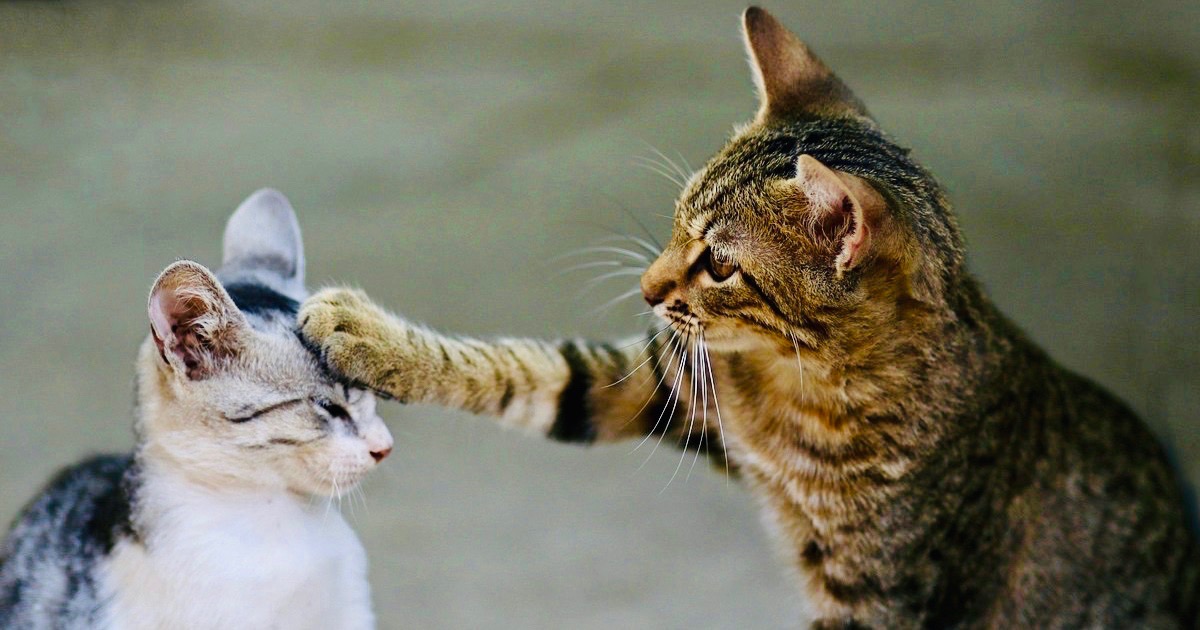Updated March 24, 2021
I wonder how many people have regretted those fateful words: “I’m going to get a kitten to keep my cat company”.
You see, cats aren’t like us. As a highly social species, we tend to assume all the others are the same. But while cats can learn to be friends, it isn’t natural and it almost never happens in the wild.
Read why by visiting our page on getting two adult cats to live together. It’s not jealousy and it’s never their fault.
Choosing A Compatible Kitten
If you haven’t chosen a kitten yet, there are things that may make it easier:
- Having the same personality
- Being a blood relative
- Gender doesn’t seem to matter
If you’ve already got a kitten don’t feel discouraged. We can do this, as you’ll see.
Getting Cats To Accept Kittens
The key word here is accept. With time, care and planning you can help your adult cat learn to tolerate and even like the new arrival. It needs to start at the very beginning when the kitten comes home.
If you rush things or just expect the two to ‘sort it out’ it could cause lasting damage.
Introducing A Kitten
A typical two-week plan is as follows:
- Set up a closed room before your kitten arrives, with all the essentials: food, water, litter, beds, toys, and amusements*. Importantly, include a wire crate in which you will feed the kitten.
- Buy a Feliway® diffuser and plug it in in your cat’s favourite room.
- Take the kitten in their travel box straight into the room, settle them there, then act as if nothing has changed with your cat.
- Do this for as many days as it takes for your cat to return to normal behaviour, popping in to see the kitten as much as you can without depriving your cat of company or play. Wash your hands after each time.
- Then start mixing scents between the two, initially just by not washing your hands. You can later use objects from the kitten’s room or even a face washer or cotton gloves to mix up the scents.
- Once happy, make a small gap into the kitten’s room (i.e. by wedging the door ajar) so your cat can investigate but also be able to back off when needed.
- Next, start confining the kitten to the crate and allowing your cat to enter the room under close supervision. Watch the behaviour of both: the kitten should only be curious, but your adult cat will probably hiss and may even attack the crate. Never punish this. Your cat is just scared.
- Once this settles, the crate can be placed into your cat’s area until your cat is used to the idea. You will still need to put the kitten back into the room for exercise most of the time.
- Finally, the kitten can be released when you are at home. It may take a long time until you are comfortable doing this while you are away though.
*This is also a good way to ensure the litter tray gets used.
But following this path alone isn’t enough. Cats are innately territorial. Once the kitten is out, you need to also pay attention to the environment. This is the key to getting two cats to get along.
Please consider the following:
Enrich The Environment

In a complex space, your cat can avoid direct confrontation with a kitten. This is especially important for your cat’s resting places, which should be:
- only able to fit one cat
- have a good view or be secluded
- only be accessed from one direction
You can make lots of these and see which ones he or she likes.
I have written many, many ideas for making your house cat-friendly.
Make Resources Abundant
There needs to be at least two of everything, and preferably three. This includes food, water, beds, resting places and especially litter trays.
A particularly important resource is your time and affection. Not all cats need it equally, but you should be alert to the needs of your existing cat.
Create Time Out Zones
I think cats have more trouble adjusting to kittens than they do to adult cats. Adult cats usually know and respect the rules of engagement, whereas kittens don’t. The key is to create time out zones.

The kitten will probably want to play with your cat constantly, but the feeling isn’t mutual. Most cats are much happier if they know that they can get away and have a snooze without worrying about the kitten all the time. Here are some ideas:
- Schedule times of day when you shut a particular door in the house with a cat on one side and a kitten on the other.
- Use microchip scanning cat-flaps so that a certain room is only open to your cat
- Allow your cat to go outside during the day, preferably into a cat run
Treat Conflict Quickly
Once conflict develops you need to decide which cat has the problem. Is it an over-confident kitten stressing a normal cat or a normal kitten stressing an anxious cat?
You need to be 100% sure so professional advice and videos are good here. If the adult is anxious, this can be easily treated by your veterinarian. Read here about the signs and treatment of anxiety in cats.
If the kitten is the problem, this is harder, but helped a lot by knowing that most kittens don’t mind being confined. You can continue to use the crate for time out, or even purchase a bigger one for long-term use.
If aggression is a problem, you can get the instigator to wear an ‘Elizabethan collar’ (the cone of shame), a loud jangly bell or a CatBib®. These will inhibit them from causing harm when out. However, please only do these under the advice of your veterinarian.
So good luck. Two cats can easily live in harmony if they feel they have enough space. It’s up to you to create that feeling!
Related: How to introduce a kitten to a dog
Have something to add? Comments (if open) will appear within 24 hours.
By Andrew Spanner BVSc(Hons) MVetStud, a vet in Adelaide, Australia. Meet his team here.

